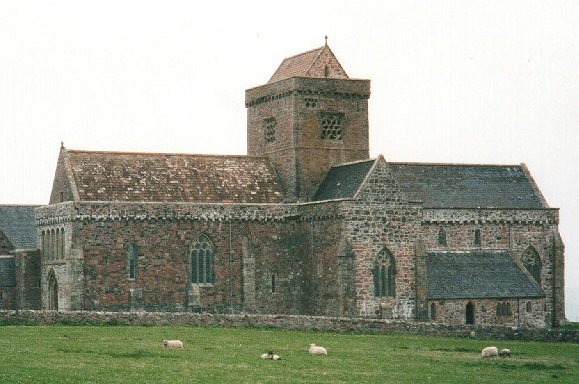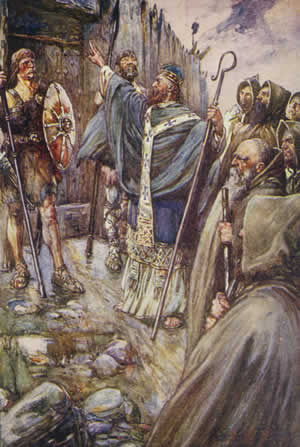|
Broichan
{{Use dmy dates, date=April 2022 Broichan is the name of a wizard who lived in 6th century Pictland and served King Bridei I. Adomnán of Iona wrote about him and his relation to St Columba during the saint's travels in Pictland. The wizard is mentioned by Adomnán as being close to the king and that he also possessed an Irish slave-girl who had possibly been a war captive. In Adomnán's account, when Columba met Broichan and Bridei at the king's fortress near the River Ness, Columba demanded that the girl be released but the wizard refused. Columba then went down to the river and told his companions that an angel at that moment had struck Broichan, and his cup had fallen from his hand and he was deathly ill. Moments later two messengers from King Bridei came to inform Columba of these events as they happened, and Columba gave his own messengers a pebble from the River Ness and told them that if Broichan agreed to release the slave-girl, then they were instructed to place the pebbl ... [...More Info...] [...Related Items...] OR: [Wikipedia] [Google] [Baidu] |
River Ness
The River Ness (Scottish Gaelic: ''Abhainn Nis'') is a river in Highland, Scotland, UK. It flows from Loch Dochfour, at the northern end of Loch Ness, north-east to the mouth of the Beauly Firth at Inverness, a distance of about , with a fall in height of about . The river is the origin of the name of Inverness which is from gd, Inbhir Nis, meaning "Mouth of the Ness". Etymology The hydronym ''Ness'' is of Pictish origin. The name may be derived from ''*Nessa'', the name of a river goddess. ''*Nessa'' preserves an Old Celtic ''*Nesta'', with roots in Indo-European ''ned'', "water", from which the Greek hydronyms '' Neda'' and '' Nestos'' are descended. Course Dochgarroch weir at the downstream end of Loch Dochfour delineates the start of the River Ness. The ''Bathymetrical survey of the Scottish fresh-water lochs'' considered Loch Dochfour to be distinct from ''Loch Ness proper'', but capable of being regarded as forming part of Loch Ness. At Carnarc Point on the west bank ... [...More Info...] [...Related Items...] OR: [Wikipedia] [Google] [Baidu] |
Pictland
The Picts were a group of peoples who lived in what is now northern and eastern Scotland (north of the Firth of Forth) during Sub-Roman Britain, Late Antiquity and the Scotland in the Early Middle Ages, Early Middle Ages. Where they lived and what their culture was like can be inferred from early medieval texts and Pictish stones. Their Latin name, , appears in written records from the 3rd to the 10th century. Early medieval sources report the existence of a distinct Pictish language, which today is believed to have been an Insular Celtic language, closely related to the Common Brittonic, Brittonic spoken by the Celtic Britons, Britons who lived to the south. Picts are assumed to have been the descendants of the Caledonians, Caledonii and other British Iron Age, Iron Age tribes that were mentioned by Roman historians or on the Ptolemy's world map, world map of Ptolemy. The Pictish kingdom, often called Pictland in modern sources, achieved a large degree of political unity in ... [...More Info...] [...Related Items...] OR: [Wikipedia] [Google] [Baidu] |
Bridei I
Bridei I, also known as Bridei, son of Maelchon, was king of the Picts from 554 to 584. Sources are vague or contradictory regarding him, but it is believed that his court was near Loch Ness and that he may have been a Christian. There were contemporaries claiming the title "king of the Picts". He died in the mid-580s, possibly in battle, and was succeeded by Gartnait son of Domelch. Historical sources Bridei son of Maelchon was king of the Picts until his death around 584–586. Other forms of his name include Brude son of Melcho and, in Irish sources, Bruide son of Maelchú and Bruidhe son of Maelchon. He was first mentioned in the Irish annals from 558 to 560, where the '' Annals of Ulster'' report "the migration before Máelchú's son, king Bruide". An earlier entry, reporting the death of "Bruide son of Máelchú" in the ''Annals of Ulster'' for 505 is presumed to be an error. The Ulster annalist does not say who fled, but the later ''Annals of Tigernach'' refers to "the ... [...More Info...] [...Related Items...] OR: [Wikipedia] [Google] [Baidu] |
Adomnán Of Iona
Adomnán or Adamnán of Iona (, la, Adamnanus, Adomnanus; 624 – 704), also known as Eunan ( ; from ), was an abbot of Iona Abbey ( 679–704), hagiographer, statesman, canon jurist, and saint. He was the author of the ''Life of Columba'' ( la, Vita Columbae), probably written between 697 and 700. This biography is by far the most important surviving work written in early-medieval Scotland, and is a vital source for our knowledge of the Picts, and an insight into the life of Iona and the early-medieval Gaelic monk. Adomnán promulgated the Law of Adomnán or "Law of Innocents" ( la, Lex Innocentium). He also wrote the treatise ('On Holy Places'), an account of the great Christian holy places and centres of pilgrimage. Adomnán got much of his information from a Frankish bishop called Arculf, who had personally visited Egypt, Rome, Constantinople and the Holy Land, and visited Iona afterwards. Life Adomnán was born about 624, a relative on his father's side of Col ... [...More Info...] [...Related Items...] OR: [Wikipedia] [Google] [Baidu] |
St Columba
Columba or Colmcille; gd, Calum Cille; gv, Colum Keeilley; non, Kolban or at least partly reinterpreted as (7 December 521 – 9 June 597 AD) was an Irish abbot and missionary evangelist credited with spreading Christianity in what is today Scotland at the start of the Hiberno-Scottish mission. He founded the important abbey on Iona, which became a dominant religious and political institution in the region for centuries. He is the patron saint of Derry. He was highly regarded by both the Gaels of Dál Riata and the Picts, and is remembered today as a Catholic saint and one of the Twelve Apostles of Ireland. Columba studied under some of Ireland's most prominent church figures and founded several monasteries in the country. Around 563 AD he and his twelve companions crossed to Dunaverty near Southend, Argyll, in Kintyre before settling in Iona in Scotland, then part of the Ulster kingdom of Dál Riata, where they founded a new abbey as a base for spreading Celtic Christianit ... [...More Info...] [...Related Items...] OR: [Wikipedia] [Google] [Baidu] |
Loch Ness
Loch Ness (; gd, Loch Nis ) is a large freshwater loch in the Scottish Highlands extending for approximately southwest of Inverness. It takes its name from the River Ness, which flows from the northern end. Loch Ness is best known for claimed sightings of the cryptozoological Loch Ness Monster, also known affectionately as "Nessie" ( gd, Niseag). It is one of a series of interconnected, murky bodies of water in Scotland; its water visibility is exceptionally low due to a high peat content in the surrounding soil. The southern end connects to Loch Oich by the River Oich and a section of the Caledonian Canal. The northern end connects to Loch Dochfour via the River Ness, which then ultimately leads to the North Sea via the Moray Firth. Loch Ness is the second-largest Scottish loch by surface area after Loch Lomond at , but due to its great depth it is the largest by volume in the British Isles. Its deepest point is , making it the second deepest loch in Scotland after Loch ... [...More Info...] [...Related Items...] OR: [Wikipedia] [Google] [Baidu] |
Pictish Culture
Pictish is the extinct Brittonic language spoken by the Picts, the people of eastern and northern Scotland from Late Antiquity to the Early Middle Ages. Virtually no direct attestations of Pictish remain, short of a limited number of geographical and personal names found on monuments and the contemporary records in the area controlled by the kingdoms of the Picts, dating to the early medieval period. Such evidence, however, points strongly to the language being an Insular Celtic language related to the Brittonic language spoken prior to Anglo-Saxon settlement in what is now southern Scotland, England, and Wales. The prevailing view in the second half of the 20th century was that Pictish was a non-Indo-European language isolate, predating a Gaelic colonisation of Scotland or that a non-Indo-European Pictish and Brittonic Pictish language coexisted. Pictish was replaced by – or subsumed into – Gaelic in the latter centuries of the Pictish period. During the reign of Domnall ... [...More Info...] [...Related Items...] OR: [Wikipedia] [Google] [Baidu] |
Pictish People
Pictish is the extinct Brittonic language spoken by the Picts, the people of eastern and northern Scotland from Late Antiquity to the Early Middle Ages. Virtually no direct attestations of Pictish remain, short of a limited number of geographical and personal names found on monuments and the contemporary records in the area controlled by the kingdoms of the Picts, dating to the early medieval period. Such evidence, however, points strongly to the language being an Insular Celtic language related to the Brittonic language spoken prior to Anglo-Saxon settlement in what is now southern Scotland, England, and Wales. The prevailing view in the second half of the 20th century was that Pictish was a non-Indo-European language isolate, predating a Gaelic colonisation of Scotland or that a non-Indo-European Pictish and Brittonic Pictish language coexisted. Pictish was replaced by – or subsumed into – Gaelic in the latter centuries of the Pictish period. During the reign of Domnall ... [...More Info...] [...Related Items...] OR: [Wikipedia] [Google] [Baidu] |


